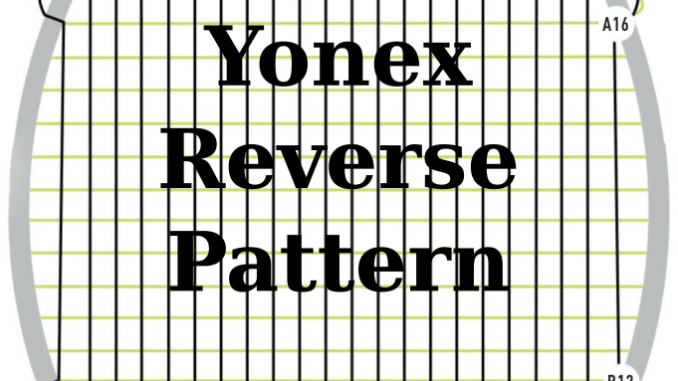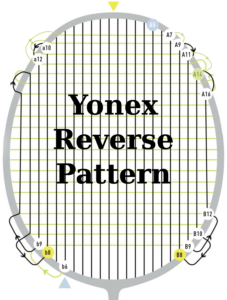
 The Yonex Stringing Team uses the reverse pattern under certain conditions. This article is about the reasons, the advantages and disadvantages.
The Yonex Stringing Team uses the reverse pattern under certain conditions. This article is about the reasons, the advantages and disadvantages.
What is the reverse patten?
You can see it in the picture on the right. The picture may vary from one racket to another due to different grommet pattern. But it can be roughly explained like this:
- Go from the fourth last cross to the last cross
- Then weave down the last two free ones
- Then tie off at the next lower shared grommet on the cross string (not main string)
Here is a video on Youtube to this topic:
As Tim Willis said in the video, they do it on high tensions, especially with Yonex Aerobite (or with thinner strings) because the strings last longer then. But why? Here are some possible reasons for it.
Possible reasons why the string no longer breaks so quickly
- Reason 1: No/less tension on the top cross.
- Possible explanation: If you knot the last top cross directly, you have a massive tension loss on the last cross. That causes that when you hit the shuttle with or above the top cross the shuttle can sink deep into the “string bed”. Which again causes that the string cannot “hit” the grommet very hard/deep.
- Reason 2: Knot is not tightened on a main.
- Possible explanation: The mains are moving more than the crosses. Therefore the knot can break (cutting through) the main string faster.
- Reason 3: Knot is away from the top of the frame.
- Possible explanation: The knot is always a weak point on miss hits. Miss hits on the top of the frame are more usual than on the side (especially when the players are better). So it’s not a bad idea to get the knot out of the miss hit area.
Positive side effects of this method
- The knot is easier to do because there is more space between the clamp and knot
- With some machines/clamps you must do a loop or reverse anyway.
Possible disadvantages of that method
- String can break more quickly on the outside of the frame (due to a bigger “mess”) while picking up the shuttles from the floor.
- You may lose your warranty in some countries if your racket breaks. In Germany they say its not strung according to the instructions.
- Not a nice looking string job because the mess of strings outside of the frame.
- “Last” cross (the cross before the knot) is at a really low tension because of the tension loss of knotting and a “very” hard weave.
When should I do this?
- With high tensions (above ~27 lbs / ~12 kg)
- With hybrid strings (e.g. Yonex Aerobite, Yonex Aerobite Boost)
- With thinner strings (thinner than 0,68 mm)
It is not a must! If you have customers whose strings break very quickly at the top of the frame, you can try this method. But always talk to the customer first and explain the advantages and disadvantages.
Myth
Knot on the mains dampens the mains. If you now knot on a cross string, you no longer damp the mains and get a little more solid and crisp feel.
I believe it’s just a fuckin myth (maybe placebo effect). The main string is damped much more by the crosses than by the knot. Above all, the knot is at the outer border or even outside the sweet spot.
In addition, the hard weave (as already mentioned by disadvantages) gives you a much looser cross-string closer to the sweet spot, which should actually result in a softer feel.
Thanks to
Links to the videos
- The Art of Stringing a Badminton Racket with Tim Willis (German Open 2022)
https://www.youtube.com/watch?v=dbf53GcUHh4 - How fast are the Best Stringers in the World? | The Art of Stringing Part 2
https://www.youtube.com/watch?v=lu2U4f679S0 - Why the string is more important than the racket! | German Open 2023 Behind the scenes
https://www.youtube.com/watch?v=UEndvRM8RtQ
Links to the discussions
- Interview with Tim Willis & Tobias Wadenka | German Open ’22
https://www.badmintoncentral.com/forums/index.php?threads/interview-with-tim-willis-tobias-wadenka-german-open-22.189282/ - Finish on your cross string
https://www.badmintoncentral.com/forums/index.php?threads/finish-on-your-cross-string.190436/